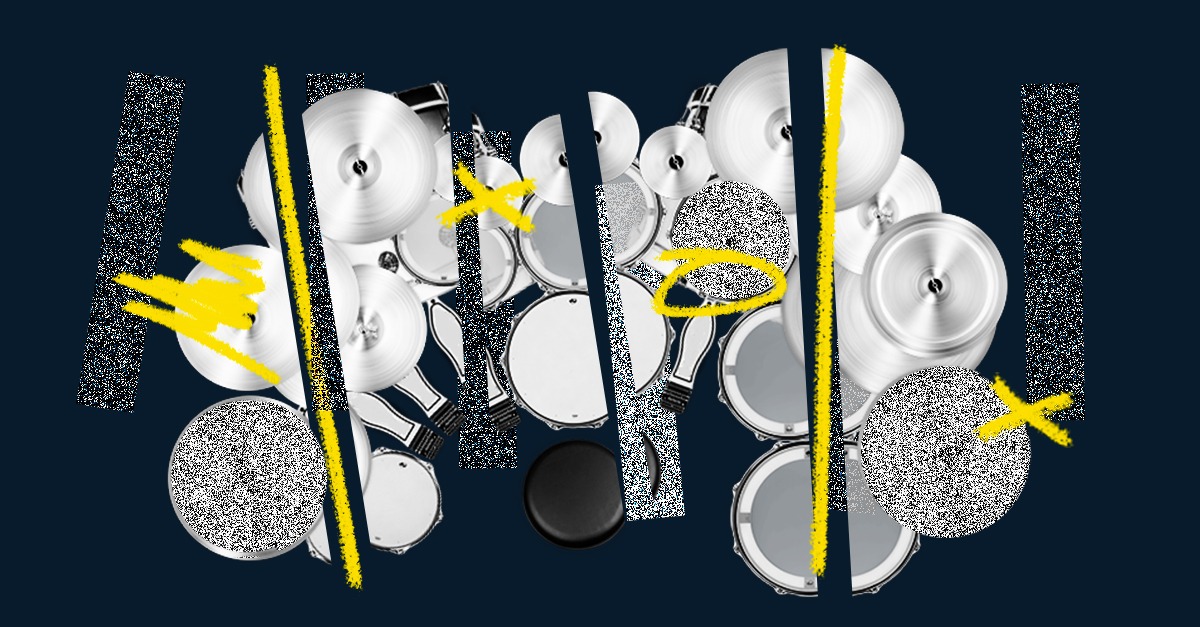Mixing Drums: How To Get a Powerful Drum Sound in 7 Steps


Drum EQ is one of the most important tasks in mixing percussion.
If you’re looking for smooth yet powerful drums that punch but leave plenty of room for the rest of the mix, EQ is essential.
But learning how to EQ drums can be challenging. After all, it’s easy to do more harm than good with aggressive equalization.
Even so, you can grasp the basics of drum EQ with a few general pointers.
Here’s my basic guide to common EQ moves from drums in 7 tips.
One of the most common recommendations for drum EQ concerns the kick.
The extreme low end energy captured by a bass drum microphone often radiates up to the low-mids.
This can cause muddiness in a mix since many other instruments occupy this frequency range
Many mix engineers use a wide EQ cut in this range to scoop out the unneeded frequencies.
Try a broad Q cut anywhere from 300 Hz to 450 Hz to see if this technique works for you.
🧠 Hot tip
Room microphones add a sense of space and depth to drum recordings.
To really shine, these tracks need a sense of airyness that extends to the upper frequencies.
If your room mics sound dull or too bassy overall, you might consider a gentle lift to emphasize the high end.
Try a smooth shelving boost beginning at 8-12 kHz to hear this drum EQ technique.
Dynamic mics like the SM57 are among the top choices for capturing snare drum in the studio.
At a close distance, this mic type can sometimes give the snare a concentrated quality in the mids.
It’s a strange mixing term to use, but many engineers refer to this quality as “boxy” sound.
Try reducing some energy in the area between 700 Hz and 1.5 kHz for a broader, more balanced sound.
🧠 Hot tip
Overhead microphones are essential to building a clear sonic picture of the drum kit.
But they can sometimes capture an unflattering perspective of the low end of the kick, toms and snare.
If blending in your overhead mics brings up too much bassy, far-away sound in the drums, you might consider shelving or high-passing them to compensate.
Start anywhere from 500 to 250 Hz with a shelf or gentle high-pass filter and shape it until your close mics are providing the majority of the low end power in the sound.
🧠 Hot tip
Toms can be difficult to hear in a dense musical texture.
If they’re tuned low and struck softly, they can be a pain to mix!
One EQ move to help them stand out is to emphasize the upper mids.
This helps the stick impact stand out so that the listener’s ears can fill in the rest.
Try a narrow boost between 2.5 kHz and 4.5 kHz and sweep to find the area that livens up the attack.
When recording snare it’s common to use two microphones to capture both sides of the drum.
Mixing the two together can give you a nice blend of body, sustain and crack that works in a mix.
But positioning a mic underneath the snare drum to capture the bottom head puts it in close proximity to the beater side of the kick drum.
You may end up with excess bleed from the kick that doesn’t contribute positively to the overall sound.
One solution is to high-pass the snare bottom mic to avoid the lows from the kick causing issues.
This is usually OK since most of the snare’s weight comes from the top head mic.
Try a steep 24 dB/octave high pass filter at frequencies up to about 400 Hz to eliminate it.
Finally, some drum and mic combinations won’t have quite enough low end force for your mix.
After all, you need solid low frequency energy to anchor the rest of the mix to the beat.
To emphasize the main thrust of the lows in the kick try a narrow boost between 50 and 70 Hz.
🧠 Hot tip
Drum EQ is a big part of creating a balanced mix.
In the end there no rules and the suggestions I’ve given above are just basic guidelines to get you started.
Even so, if you try these tips you’ll have some basic techniques to experiment with.
Now that you know the basics of drum EQ, get back to your DAW and keep mixing your masterpiece.
Gear guides, tips, tutorials, inspiration and more—delivered weekly.
Keep up with the LANDR Blog.